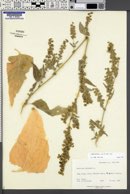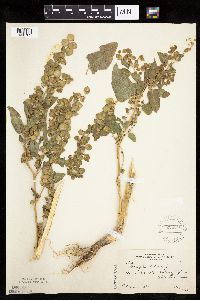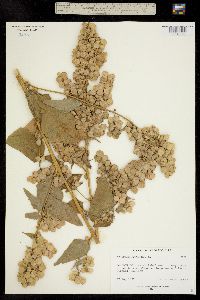Atriplex hortensis
|
|
|
|
Family: Amaranthaceae
Garden Orache
[Atriplex acuminata M.Bieb., moreAtriplex hortensis subsp. nitens , Atriplex hortensis var. atrosanguinea , Atriplex hortensis var. rubra , Atriplex nitens Schkuhr] |
Herbs, green to yellowish or reddish, 5-15(-25) dm, glabrous. Stems erect, mostly branched. Leaves mostly opposite or mostly alternate; petiole 0.3-4+ cm; blade green on both sides, ovate or ovate-lanceolate to cordate-hastate at base, 15-180 × 8-135 mm, margin entire or more rarely irregularly toothed or lobed, apex attenuate to acuminate or rounded. Inflorescences of spikes disposed in leafless panicles. Staminate flowers 5-merous. Pistillate flowers dimorphic, some ebracteolate and with 5-parted perianth, others without perianth enclosed by a pair of sessile or very shortly stipitate bracteoles. Fruiting bracteoles samaralike, orbicular to oval or ovate, compressed, 5-18 mm, united only at base, entire, faces smooth. Seeds of ebracteate flowers black, horizontal, convex, 1-2 mm wide, lustrous; those of bracteolate flowers olivaceous brown, vertical, flat, 3-4.5 mm wide, dull. 2n = 18. Flowering summer-fall. Roadsides, canal and stream banks, lake shores, disturbed sites and gardens; 0-2200 m; introduced; Alta., B.C., Man., Ont., Que.,Sask., Yukon; Alaska, Calif., Colo., Conn., Idaho, Ill., Ind., Iowa, Mass., Minn., Mont., Nebr., Nev., N.J., N.Y., N.Dak., Oreg., S.Dak., Utah, Wash., Wis., Wyo.; Asia. Atriplex hortensis has been widely grown as a potherb, has escaped from cultivation, and is now established especially in moist ruderal sites. It is easily distinguished by its rounded, samaralike, entire, and smooth fruiting bracteoles, and the presence of two kinds of pistillate flowers, the one enclosed by bracteoles and lacking sepals, the other without bracteoles but subtended by sepals. Atriplex nitens (see list of excluded taxa) is distinguished from A. hortensis in Flora Europea (P. Aellen 1964b) by having leaf blades densely white scurfy beneath, the distal surface lustrous, as opposed to green and dull for A. hortensis. Occasional specimens, treated here as A. hortensis, have leaves somewhat scurfy.
Annual herb to 2 m tall Stem: decumbent or upright, branched. Leaves: opposite or alternate (mostly one or the other), on a 0.3 - 4 cm long stalk, 15 mm - 18 cm long, 8 mm - 13.5 cm wide, egg-shaped to broadly triangular with a rounded to pointed tip, sometimes irregularly toothed or lobed, more or less mealy. Inflorescence: a large, leafless, branched cluster of flowers (panicle) growing in spikes. Flowers: either male or female, borne on the same plant (monoecious), in separate spikes or mingled together, greenish, tiny. Male flowers with five sepals and stamens. Female flowers with or without petals and sepals, the ones without being enclosed within a pair of small, leaf-like bracts (bracteoles). Stigmas two. Fruit: bractless or enclosed within a pair of small bracts (bracteoles). Bracteoles separate, united at base, 5 - 18 mm long, orbicular to rounded or egg-shaped with a broadly blunt apex, compressed, sometimes small-toothed, wrinkled. Seeds of bractless flowers horizontal, black, 1 - 2 mm wide, convex, and shiny. Seeds with bracteoles vertical, brownish, 3 - 4.5 mm wide, flat, and dull. Similar species: This species is easily distinguished by its female flowers, some of which bear petals and sepals, and by its rounded and wrinkled fruiting bracteoles. Flowering: August to September Habitat and ecology: Introduced from Asia and sometimes grown as a garden vegetable. A rare escape from cultivation to weedy waste ground. Occurence in the Chicago region: non-native Etymology: Atriplex is the ancient Latin name for this plant. Hortensis means cultivated or "of gardens." Author: The Morton Arboretum Erect or decumbent, to 2 m; lvs becoming green, ovate to broadly deltoid, to 15 cm; staminate and pistillate fls in separate spikes or mingled, forming a large, paniculate infl; some pistillate fls with a horizontal seed, 4-5-lobed persistent cal, and no bracteoles, but most with vertical seed, no perianth, and 2 persistent bracteoles (as in other spp. of Atriplex); fruiting bracteoles thin, separate, to 15 mm, rotund-ovate or suborbicular, broadly obtuse, entire or denticulate, conspicuously reticulate; seed apparently central, its radicle inferior; 2n=18. Native of Asia, cult. as a pot herb, and rare as a waif in our range. (A. nitens) Gleason, Henry A. & Cronquist, Arthur J. 1991. Manual of vascular plants of northeastern United States and adjacent Canada. lxxv + 910 pp. ©The New York Botanical Garden. All rights reserved. Used by permission. |





















































































